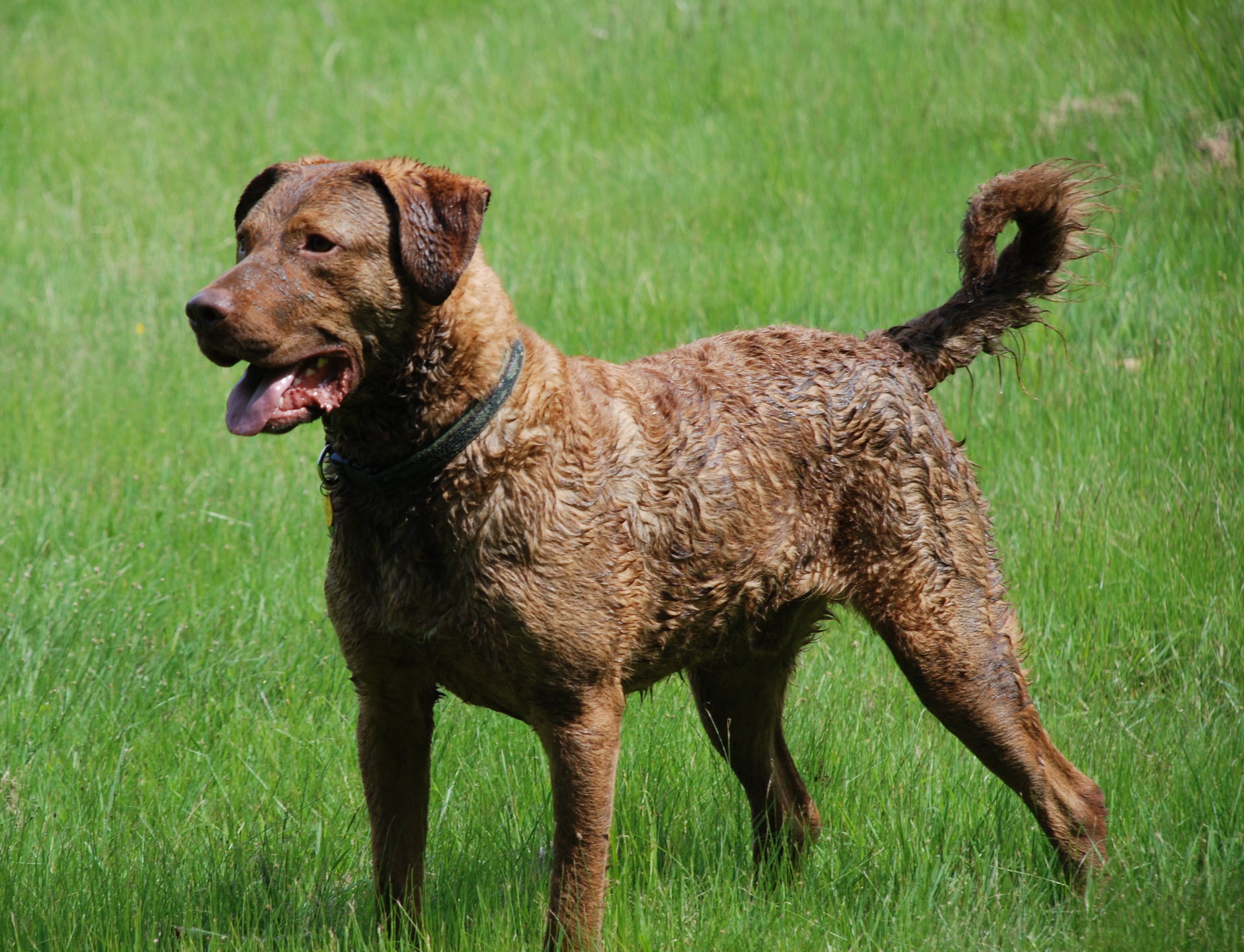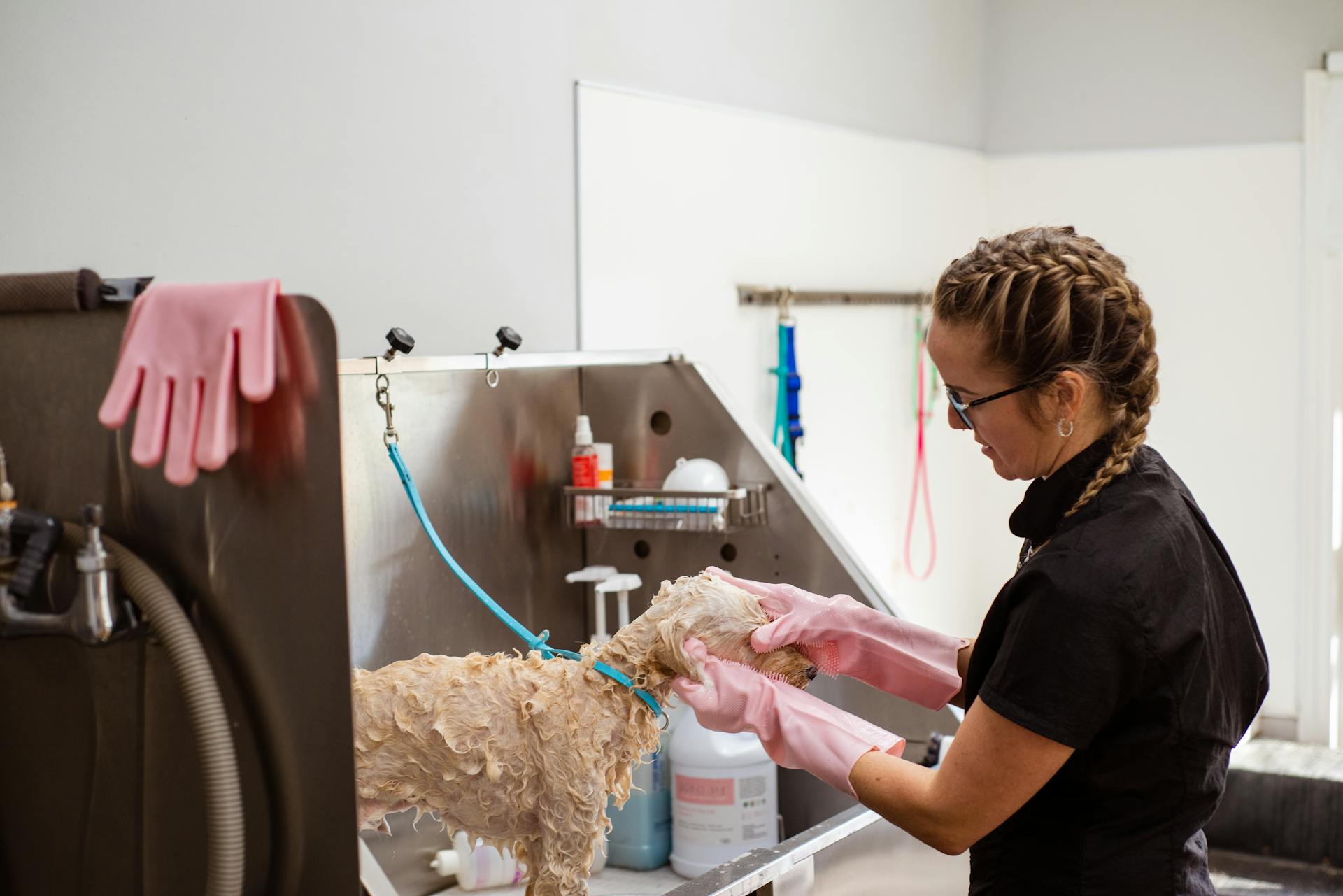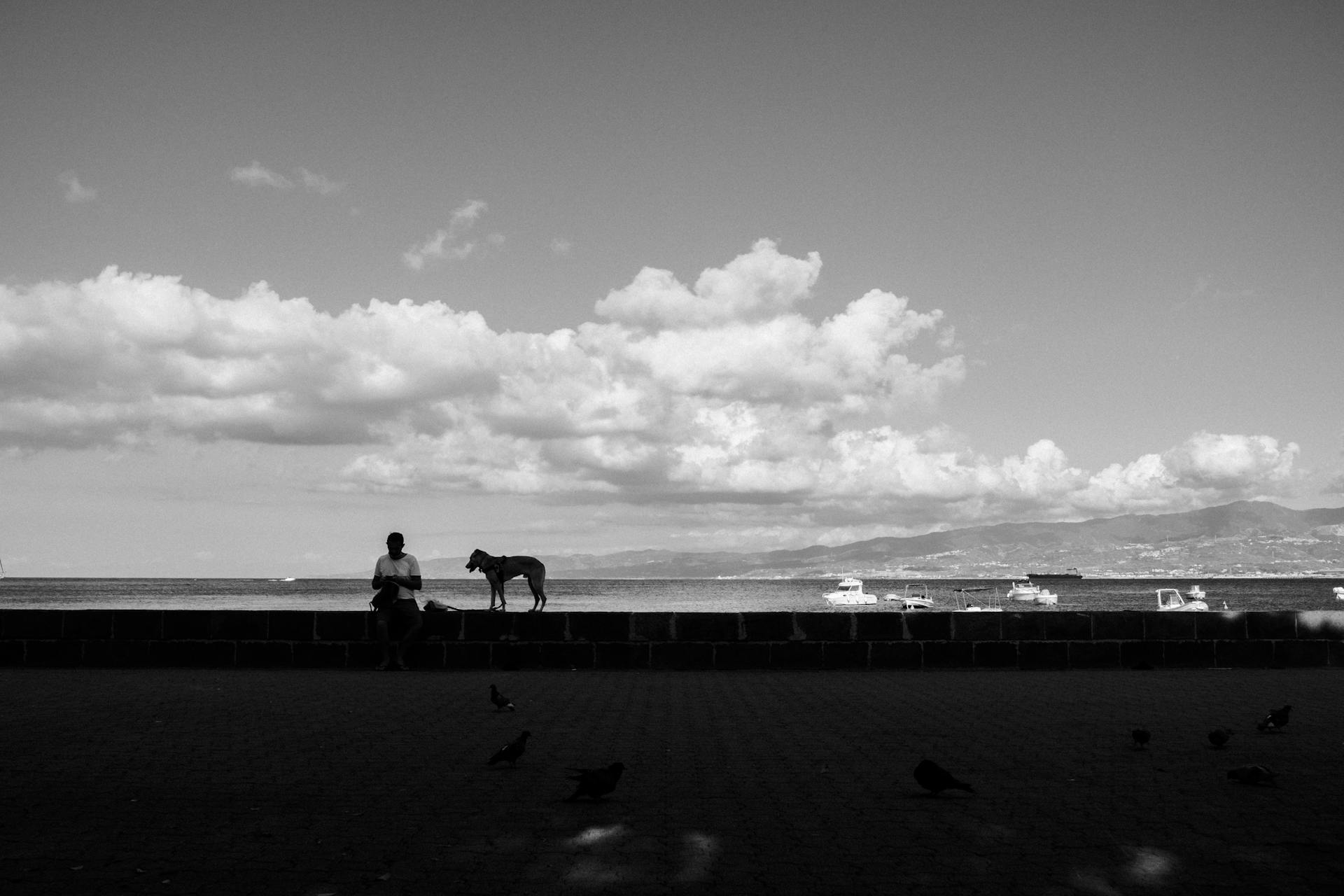
The Chesapeake Bay Retriever is a natural hunting companion, bred to retrieve waterfowl in the harsh waters of the Chesapeake Bay. They're built for the task, with a water-resistant coat and webbed feet.
Their origins date back to the 19th century, when they were developed from a mix of various breeds, including the Cur and the Newfoundland. This unique heritage has given them a distinct set of skills that make them well-suited for hunting.
To get the most out of your Chesapeake Bay Retriever as a hunting partner, it's essential to understand their instincts and behaviors. They have a strong prey drive and are naturally inclined to follow their nose, which can be both a blessing and a curse in the field.
Breed Info
The Chesapeake Bay Retriever is a breed born of the 19th century, rumored to be a mix of Newfoundlands, Irish Water Spaniels, and other indistinct hounds.
Their unique double coat is a telltale sign of the breed, wavy, thick, and oily to the touch, making it extremely water-resistant and quick-drying.
Height ranges from 21-26″ at the shoulder, and weights from 55-80 pounds, with males tend to be bigger and heavier than females.
A Chessie's personality is complex, with an independent streak matched with intense loyalty to their owners and families.
They can become wary of strangers if not properly socialized, but make for a better watchdog than other retrievers.
The Chessie is highly intelligent and trainable, making them excellent working dogs, and they're also found in bomb-sniffing units and search-and-rescue teams.
Training and Behavior
The Chesapeake Bay Retriever is an intelligent breed that learns quickly, but they can be stubborn and require consistent, daily obedience training.
To keep your Chessie engaged, it's essential to be creative with your training scenarios and keep things light and fun. Repetition can create boredom in this breed.
Molly Boland, a seasoned trainer, emphasizes the importance of being courteous when training a Chessie. They don't have much patience for mistakes and will question your authority if you make errors.
Consistent handling and kind, patient training are crucial for effective training. This breed needs to be kept busy mentally, so training should be a regular part of their routine.
Chesapeake Bay Retrievers are generally good with children, but they can be reserved with strangers and may need time to warm up to new friends. Adult supervision is recommended when interacting with children.
To prevent dominance problems, socialization and training should start early in life. With proper training and socialization, this breed can make an excellent family companion.
Exercise is essential for Chesapeake Bay Retrievers, and they require at least 20 minutes of daily intensive exercise or an hour-long daily walk.
See what others are reading: How Much Exercise Do Labrador Retrievers Need
Health and Maintenance
Chesapeake Bay Retrievers are generally healthy dogs, but they can be prone to joint issues like hip dysplasia, so regular vet trips are a must.
A weekly brisk brushing is essential to maintain their healthy coat, which is naturally slightly oily with a mild musky smell.
Daily exercise is crucial for this breed, a good walk or swim every day is highly recommended, as they are bred to be water athletes.
Their coat should only be bathed 3 to 4 times a year, as washing it too often can destroy the water resistance.
A medium to high shedder, they require regular grooming to remove dead hairs, and their ears and eyes tend to stay clean, but should be regularly checked.
Proper nutrition is also key, feeding them 1 to 1.5 cups of quality dog food twice a day, depending on their activity level and age.
You might like: Shiba Inu Reaching 1 Cent
Breed Maintenance
The Chesapeake Bay Retriever's coat needs regular brushing to stay healthy, so aim for a weekly brisk brushing to remove dead hairs and maintain that natural oiliness.
This breed is a medium to high shedder, so be prepared for regular hair removal.
You'll want to use a firm bristle brush for this task, as it's gentle enough for their coat yet effective at removing dead hairs.
On a similar theme: Why Are Labradors so Popular
Bathing is a rare occurrence for the Chesapeake Bay Retriever, with a maximum of 3 to 4 times a year recommended.
This is because washing the coat too often can destroy its water resistance and strip away the protective oil.
The ears and eyes of this breed tend to stay clean naturally, but it's still essential to check them regularly.
You should also have their teeth professionally cleaned once a year to keep them healthy.
Daily exercise is crucial for the Chesapeake Bay Retriever, with a good walk or swim every day highly recommended.
This breed is bred to be a water athlete, after all.
They can live outside in temperate to cool climates, but a fenced yard is necessary for them to play and exercise properly.
It's not recommended for apartment dwelling due to their need for space and exercise.
If you don't provide enough exercise, this breed can become bored and restless.
Feeding them is relatively straightforward, with an average of 1 to 1.5 cups of quality dog food twice a day recommended, depending on their activity level and age.
Discover more: Boston Terrier Day
Chessie's Health
Chessie's Health is a top priority for any responsible dog owner. Chesapeake Bay Retrievers tend to be very healthy dogs who live long lives for the size of their breed.
Proper mental and physical exercise is essential to keep your Chessie happy and healthy. Regular trips to the vet are necessary to monitor their overall health.
Hip dysplasia is a common joint issue that can affect Chessies, so it's best to keep an eye out for any signs of discomfort or stiffness.
Hunting and Uses
The Chesapeake Bay Retriever is a versatile and resilient breed, developed from a foundation of two Newfoundland puppies rescued by Captain John Mercer in the early 19th century.
Their webbed feet, oily double coat, and powerful swimming abilities make them well-suited for navigating harsh conditions, including cold waters and icy conditions.
In fact, they can break ice and swim in rough waters, making them a great companion for hunting waterfowl in frigid weather and cold water.
Their work ethic is "indefatigable", according to the American Kennel Club, and they can retrieve birds for longer than you might feel comfortable standing outside.
Their strong constitution and waterproof coat keep them focused and warm in all sorts of weather, making them a reliable retriever for hunters.
Similarly Sized Breeds
If you're looking for breeds that are similarly sized to the Chesapeake Bay Retriever, you've got several options.
The Standard Schnoodle is one such breed, with a similarity score of 98%. This hybrid breed combines the intelligence and loyalty of a Poodle with the friendly nature of a Schnauzer.
The Labrador Retriever is another breed that shares a similar size, with a similarity score of 97%. This breed is known for its high energy level and love of water, making it a great companion for outdoor enthusiasts.
The Swedish Elkhound is also a breed that's similar in size, with a similarity score of 97%. This breed is known for its strong prey drive and love of hunting, making it a great choice for those who enjoy tracking and retrieving game.
The Rhodesian Boxer is another breed that's similar in size, with a similarity score of 97%. This breed is known for its energetic and playful personality, making it a great choice for families with children.
Curious to learn more? Check out: Dogs Similar to Border Collies
The Chesador is a breed that's similar in size, with a similarity score of 97%. This hybrid breed combines the loyalty and intelligence of a Labrador Retriever with the hunting ability of a Chesapeake Bay Retriever.
Here are some breeds that are similarly sized to the Chesapeake Bay Retriever:
- Standard Schnoodle (98% Similar)
- Labrador Retriever (97% Similar)
- Swedish Elkhound (97% Similar)
- Rhodesian Boxer (97% Similar)
- Chesador (97% Similar)
Hunting
The Chesapeake Bay Retriever is a natural in the field, thanks to its origins as a waterfowl hunter in the Chesapeake Bay region. They can break ice, swim in rough waters, and retrieve birds for hours on end.
Their waterproof coat is a game-changer in frigid weather, keeping them warm and focused on the job. This is especially true for waterfowl hunting, where they can withstand cold waters and icy conditions with ease.
The American Kennel Club described the Chessie's work ethic as "indefatigable", meaning they're tireless in their efforts to retrieve birds. This is a testament to their strong constitution and determination.
In addition to waterfowl hunting, Chesapeake Bay Retrievers are also skilled upland flusers, making them a versatile companion in the field. Their work ethic spills over into whatever terrain they face, making them a valuable asset to any hunting team.
Reputable breeders will provide hip dysplasia checks and health certifications, ensuring that you're getting a healthy and capable companion for your hunting adventures.
Sources
- https://gunner.com/blogs/pack/chesapeake-bay-retrievers-breed-profile
- https://www.akc.org/dog-breeds/chesapeake-bay-retriever/
- https://gearjunkie.com/outdoor/hunt-fish/hunting-chesapeake-bay-retriever
- https://en.wikipedia.org/wiki/Chesapeake_Bay_Retriever
- https://wagwalking.com/breed/chesapeake-bay-retriever
Featured Images: pexels.com


